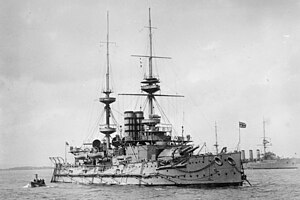
Back Třída Majestic Czech Majestic-Klasse (1895) German نبردناو کلاس مجستیک Persian Majestic-luokka (taistelulaiva) Finnish Classe Majestic (cuirassé) French אוניות המערכה מסדרת מג'סטיק HE Classe Majestic (nave da battaglia) Italian マジェスティック級戦艦 Japanese Classe Majestic Portuguese Броненосцы типа «Маджестик» Russian

| |
| Class overview | |
|---|---|
| Name | Majestic-class battleship |
| Builders | |
| Operators | Royal Navy |
| Preceded by | HMS Renown |
| Succeeded by | Canopus class |
| Built | 1893–1898 |
| In commission | December 1895 – November 1921 |
| Completed | 9 |
| Lost | 1 |
| Retired | 8 |
| General characteristics | |
| Type | Pre-dreadnought battleship |
| Displacement | 16,060 long tons (16,320 t) |
| Length | 421 ft (128 m) |
| Beam | 75 ft (23 m) |
| Draught | 27 ft (8.2 m) |
| Installed power |
|
| Propulsion | 2 × 3-cylinder triple-expansion steam engines, twin screws |
| Speed | 16 kn (30 km/h; 18 mph) |
| Complement | 672 |
| Armament | |
| Armour |
|
The Majestic class of nine pre-dreadnought battleships were built for the Royal Navy in the mid-1890s under the Spencer Programme, named after the First Lord of the Admiralty, John Poyntz Spencer. With nine units commissioned, they were the most numerous class of battleships. The nine ships, HMS Majestic, Caesar, Hannibal, Illustrious, Jupiter, Magnificent, Mars, Prince George, and Victorious, were built between 1894 and 1898 as part of a programme to strengthen the Royal Navy versus its two traditional rivals, France and Russia. This continued the naval re-armament initiatives begun by the Naval Defence Act 1889.
The Majestics introduced a number of significant improvements to British battleship design, including armoured gun shields for the barbette-mounted main battery guns. The ships were armed with a main battery of four BL 12-inch Mark VIII guns, the first large-calibre weapon in the Royal Navy to use smokeless propellant, which made it superior in almost all respects to earlier, larger guns. They were also the first British ships to incorporate Harvey armour, which allowed them to carry a much more comprehensive level of protection. The ships proved to be among the most successful designs of their day, and they were widely copied in foreign navies, including the Japanese Shikishima class and the battleship Mikasa, which were both modified versions of the Majestic design.
The nine ships served in a variety of roles throughout their careers. They primarily served in the Channel Fleet, though several took rotations in the Mediterranean Fleet, and Victorious served on the China Station in 1900–02. No longer frontline ships by the outbreak of World War I in July 1914, the vessels were used to protect the crossing of the British Expeditionary Force and various points on the British coast. In 1915, several of the ships were disarmed, their guns going to equip the Lord Clive-class monitors. The disarmed battleships were used as troop ships during the Dardanelles Campaign, and Prince George and Majestic were used to bombard enemy positions before Majestic was torpedoed by a German U-boat. The surviving ships were employed in secondary roles from 1915 onwards, and after the war, all were sold for scrapping in 1920–22. Only one, Prince George, avoided the breakers' yards by wrecking off Camperduin.
© MMXXIII Rich X Search. We shall prevail. All rights reserved. Rich X Search